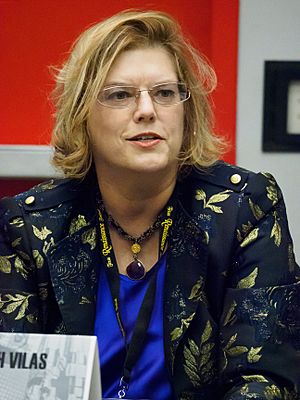Faith Vilas facts for kids
Quick facts for kids
Faith Vilas
|
|
|---|---|
 |
|
| Born | 1952 |
| Alma mater | |
| Occupation | Scientist |
| Awards |
|
| Website | www |
| Position held | scientist (1999–2011), director (2005–2010), chair (1996–1997) |
Faith Vilas is an American scientist who studies planets and space. She used to be the Director of the MMT Observatory in Arizona. She has made many important discoveries about planets, asteroids, and even space junk!
Contents
Her Journey to Becoming a Scientist
Faith Vilas loved learning about space from a young age. She studied astronomy at Wellesley College, getting her first degree in 1973. Then, she went to MIT to study Earth and Planetary Sciences, earning another degree in 1975. She finished her highest degree, a doctorate, in Planetary Sciences in 1984 at the University of Arizona. This prepared her for an amazing career exploring the universe!
Exploring Space and Planets
Working at NASA
From 1985 to 2005, Faith Vilas worked as a scientist at NASA Johnson Space Center. Here, she studied space debris, which is like trash orbiting Earth. Her work helped scientists understand how much space junk was out there.
She also made an amazing discovery about the planet Neptune. Her observations helped show that Neptune had rings, even before a special mission called Voyager confirmed it in 1989!
Designing Special Tools
In 1984, Faith Vilas designed a special tool called a coronagraph. This tool helped create the very first image of a disk of dust and gas around another star, called Beta Pictoris. This was a huge step in understanding how planets might form around other stars.
She also worked a lot on the planet Mercury. She even helped edit a book about Mercury in 1989.
Discovering Water on Asteroids
Faith Vilas was a pioneer in finding water-rich minerals on asteroids. She used a special way to spot these minerals by looking for a certain light absorption. This method is now used to classify asteroids. It could even help future companies find water on asteroids for space travel or mining!
Adventures in Antarctica
In 1987 and 1988, Faith Vilas went on an exciting trip to Antarctica. She was part of the Antarctic Search for Meteorites team. She helped collect almost 700 meteorites from the ice fields there. Imagine finding pieces of space rocks on Earth!
Leading Space Missions
Faith Vilas also helped manage important space missions at NASA Headquarters from 2001 to 2002. She made sure that new space projects were chosen fairly.
Later, from 2005 to 2010, she became the director of the Multiple Mirror Telescope Observatory. She was in charge of running the huge telescopes and making plans for the observatory's future.
Current Work and New Discoveries
In 2011, Faith Vilas joined the Planetary Science Institute. She worked on NASA's MESSENGER mission, which studied Mercury. She also worked on the Atsa Suborbital Observatory Project.
Currently, she is part of the team for NASA's Lunar Reconnaissance Orbiter LAMP project, which studies the Moon. She is also on the team for the Japanese Hayabusa-2 mission, which visited an asteroid named 162173 Ryugu.
From 2015 to 2018, she worked at the National Science Foundation, helping to guide research about planets and planets outside our solar system. She has since returned to the Planetary Science Institute. In 2019, she became an editor for important astronomy journals. She was also named the first editor of The Planetary Science Journal, a new science magazine.
Awards and Special Recognition
Faith Vilas has received many important awards for her work:
- In 2018, the American Astronomical Society gave her the Harold Masursky Award for her great service to planetary science.
- In 2019, the American Geophysical Union gave her the Fred Whipple Award for her big contributions to studying planets.
- She was chosen as a Legacy Fellow of the American Astronomical Society in 2020.
- There's even an asteroid named after her! It's called 3507 Vilas.
- In 2023, her old college, Wellesley College, gave her the Alumnae Achievement Award. This award honors graduates who have done amazing things.
Her Life Outside of Science
Faith Vilas is also a trained pilot, just like many people in her family. Her grandfather was the first person to fly across Lake Michigan. To celebrate 100 years since his flight, she flew the same path! Faith Vilas is married to Larry W. Smith, who is an engineer.

